Entropy-Based Investigation on the Precipitation Variability over the Hexi Corridor in China
Abstract
:1. Introduction
2. Materials and Methods
2.1. Marginal Entropy
2.2. Intensity Entropy
2.3. Apportionment Entropy
2.4. Entropy-Based Variability
3. Data
4. Results and Discussion
4.1. Variability of Annual, Seasonal, and Monthly Precipitation
4.2. Variability of Precipitation Apportionment and Intensity
4.3. Decadal Variability of Precipitation Amount and Precipitation Days
4.4. Implication for Crop Production
4.5. Co-Variability with Other Meteorological Variables
5. Conclusions
- The annual variability is mainly contributed to by the winter variability. The precipitation intensity is diversified due to the difference in spatial variability between the monthly precipitation amount and the number of precipitation days. The contributions of different months to seasonal variability are different. A high contribution is detected in March for spring and in December for the winter period.
- More variability during 2001–2010 is found for the precipitation time series in January, May, June, and July when we consider precipitation days. Regarding the precipitation amount, the variability in February, June, and July has increased in the recent decade.
- The variability in terms of the precipitation amount and precipitation days decreases from the western part of the Hexi corridor to the eastern part of the region, which indicates more precipitation uncertainty is accommodated in the western part. From the temporal domain, the variability in the recent decade is relatively stronger than the previous decades.
- The crop yield in historical periods is correlated with the precipitation intensity disorder index for the middle reaches of the Hexi corridor.
Acknowledgments
Author Contributions
Conflicts of Interest
References
- Mishra, A.K.; Özger, M.; Singh, V.P. An entropy-based investigation into the variability of precipitation. J. Hydrol. 2009, 370, 139–154. [Google Scholar] [CrossRef]
- Hulme, M.; Doherty, R.; Ngara, T.; New, M.; Lister, D. African climate change: 1900–2100. Clim. Res. 2001, 17, 145–168. [Google Scholar] [CrossRef]
- Easterling, D.R.; Evans, J.L.; Groisman, P.Y.; Karl, T.R.; Kunkel, K.E.; Ambenje, P. Observed variability and trends in extreme climate events: A brief review. Bull. Am. Meteorol. Soc. 2000, 81, 417–425. [Google Scholar] [CrossRef]
- Karl, T.R.; Knight, R.W. Secular trends of precipitation amount, frequency, and intensity in the United States. Bull. Am. Meteorol. Soc. 1998, 79, 231–241. [Google Scholar] [CrossRef]
- Wang, F.; Niu, J. The implication of climate signal for precipitation in the Heihe River basin, Northwest China. Adv. Meteorol. 2016, 2016, 1078617. [Google Scholar] [CrossRef]
- Shannon, C.E. A mathematical theory of communication. Bell. Syst. Tech. J. 1948, 27, 379–423. [Google Scholar] [CrossRef]
- Jaynes, E.T. Information theory and statistical mechanics, I. Phys. Rev. 1957, 106, 620–630. [Google Scholar] [CrossRef]
- Jaynes, E.T. Information and statistical mechanics, II. Phys. Rev. 1957, 108, 171–190. [Google Scholar] [CrossRef]
- Cui, H.; Singh, V.P. On the cumulative distribution function for entropy-based hydrologic modeling. Trans. ASABE 2012, 55, 429–438. [Google Scholar] [CrossRef]
- Cui, H.; Singh, V.P. Computation of suspended sediment discharge in open channels using Tsallis entropy—Based Methods and Empirical Formulas. J. Hydrol. Eng. 2013, 19, 18–25. [Google Scholar] [CrossRef]
- Cui, H.; Singh, V.P. Configurational entropy theory for streamflow forecasting. J. Hydrol. 2015, 521, 1–7. [Google Scholar] [CrossRef]
- Cui, H.; Singh, V.P. Minimum relative entropy theory for streamflow forecasting with frequency as a random variable. Stoch. Environ. Res. Risk Assess. 2016, 30, 1545–1563. [Google Scholar] [CrossRef]
- Singh, V.P. The use of entropy in hydrology and water resources. Hydrol. Process. 1997, 11, 587–626. [Google Scholar] [CrossRef]
- Singh, V.P. Entropy Theory in Hydrologic Science and Engineering; McGraw-Hill Education: New York, NY, USA, 2015. [Google Scholar]
- Sivakumar, B. Chaos theory in hydrology: Important issues and interpretations. J. Hydrol. 2000, 227, 1–20. [Google Scholar] [CrossRef]
- Sivakumar, B. Chaos Identification and Prediction Methods. In Chaos in Hydrology; Springer: Dordrecht, The Netherlands, 2017; pp. 173–197. [Google Scholar]
- Dwivedi, D.; Mohanty, B.P. Hot spots and persistence of nitrate in aquifers across scales. Entropy 2016, 18, 25. [Google Scholar] [CrossRef]
- Maruyama, T.; Kawachi, T.; Maeda, S. Entropy-based Assessments of Monthly Rainfall Variability. J. Rainwater Catchment Syst. 2002, 8, 21–25. [Google Scholar] [CrossRef]
- Khan, M.I.; Liu, D.; Fu, Q.; Azmat, M.; Luo, M.; Hu, Y.; Zhang, Y.; Abrar, F.M. Precipitation variability assessment of northeast China: Songhua River basin. J. Earth Syst. Sci. 2016, 125, 957–968. [Google Scholar] [CrossRef]
- Atieh, M.; Rudra, R.; Gharabaghi, B.; Lubitz, D. Investigating the Spatial and Temporal Variability of Precipitation using Entropy Theory. J. Water Manag. Model. 2017. [Google Scholar] [CrossRef]
- Arora, B.; Dwivedi, D.; Hubbard, S.S.; Steefel, C.I.; Williams, K.H. Identifying geochemical hot moments and their controls on a contaminated river-floodplain system using wavelet and entropy approaches. Environ. Model. Softw. 2016, 85, 27–41. [Google Scholar] [CrossRef]


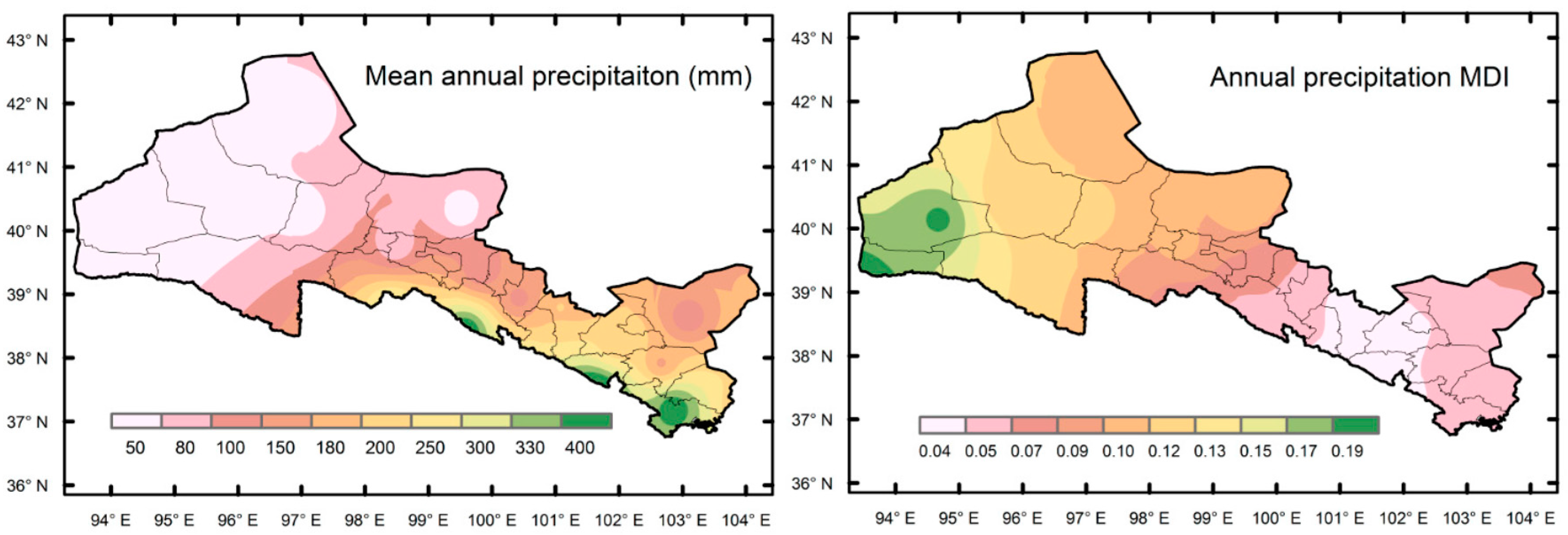
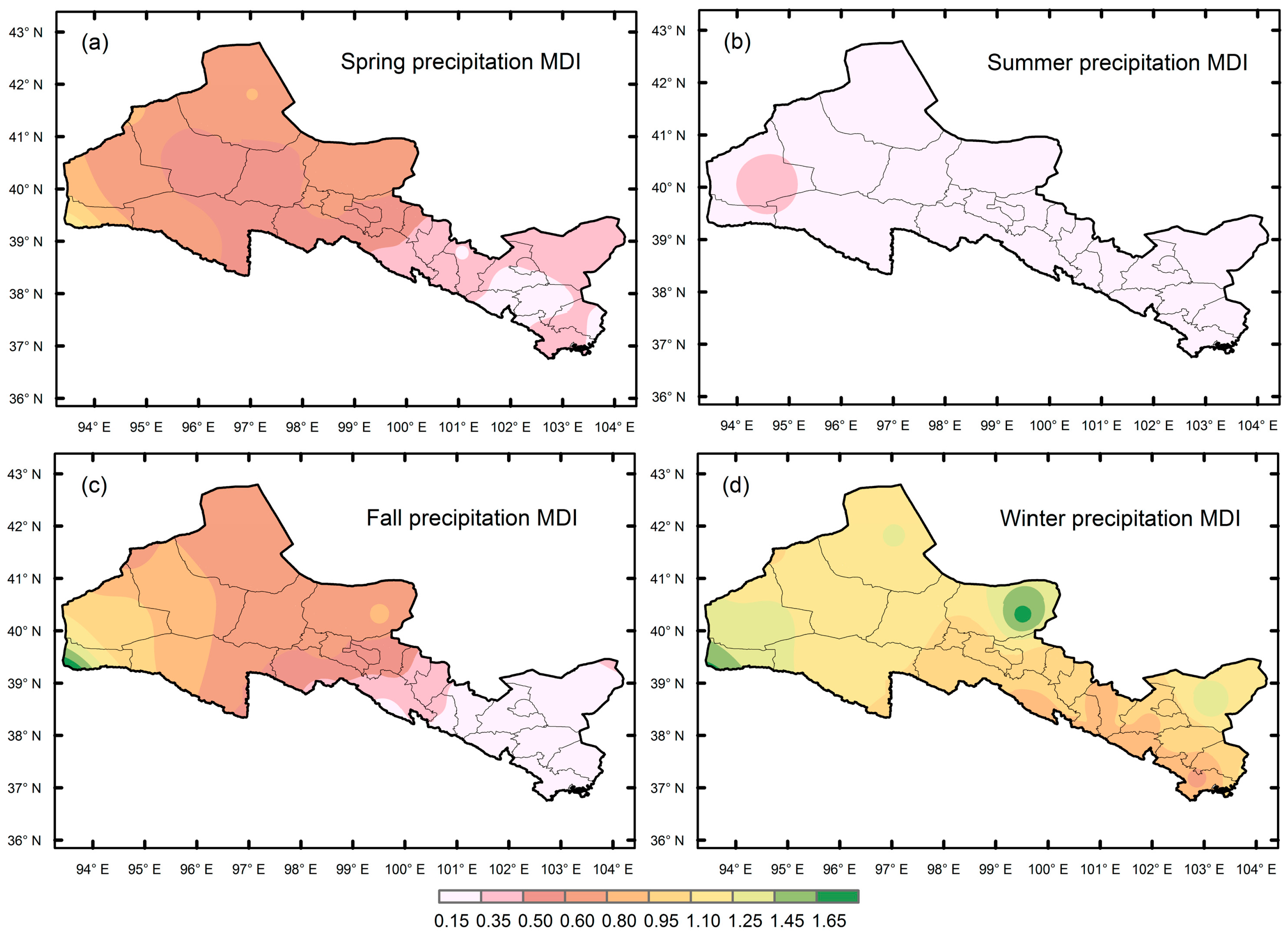


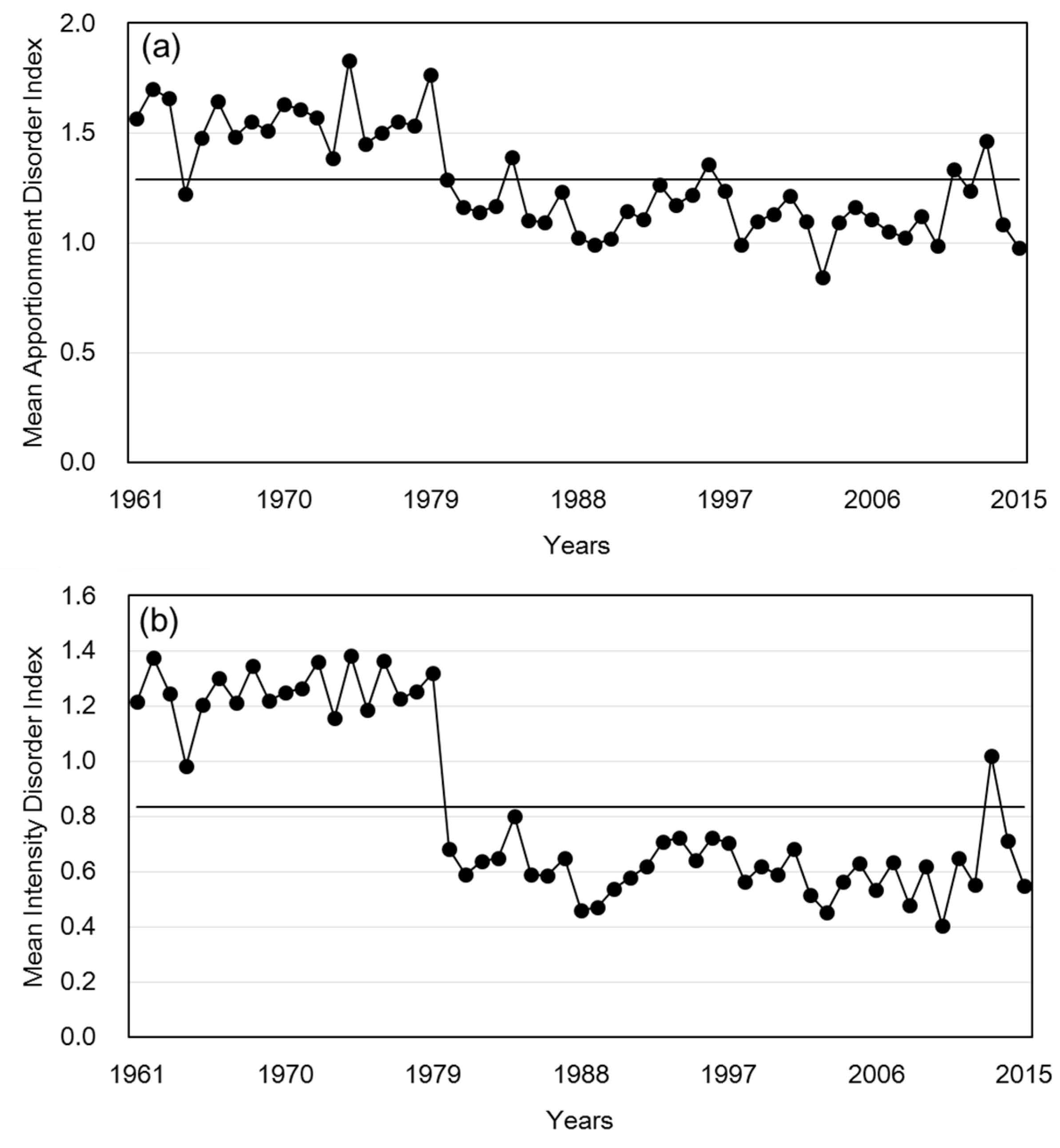
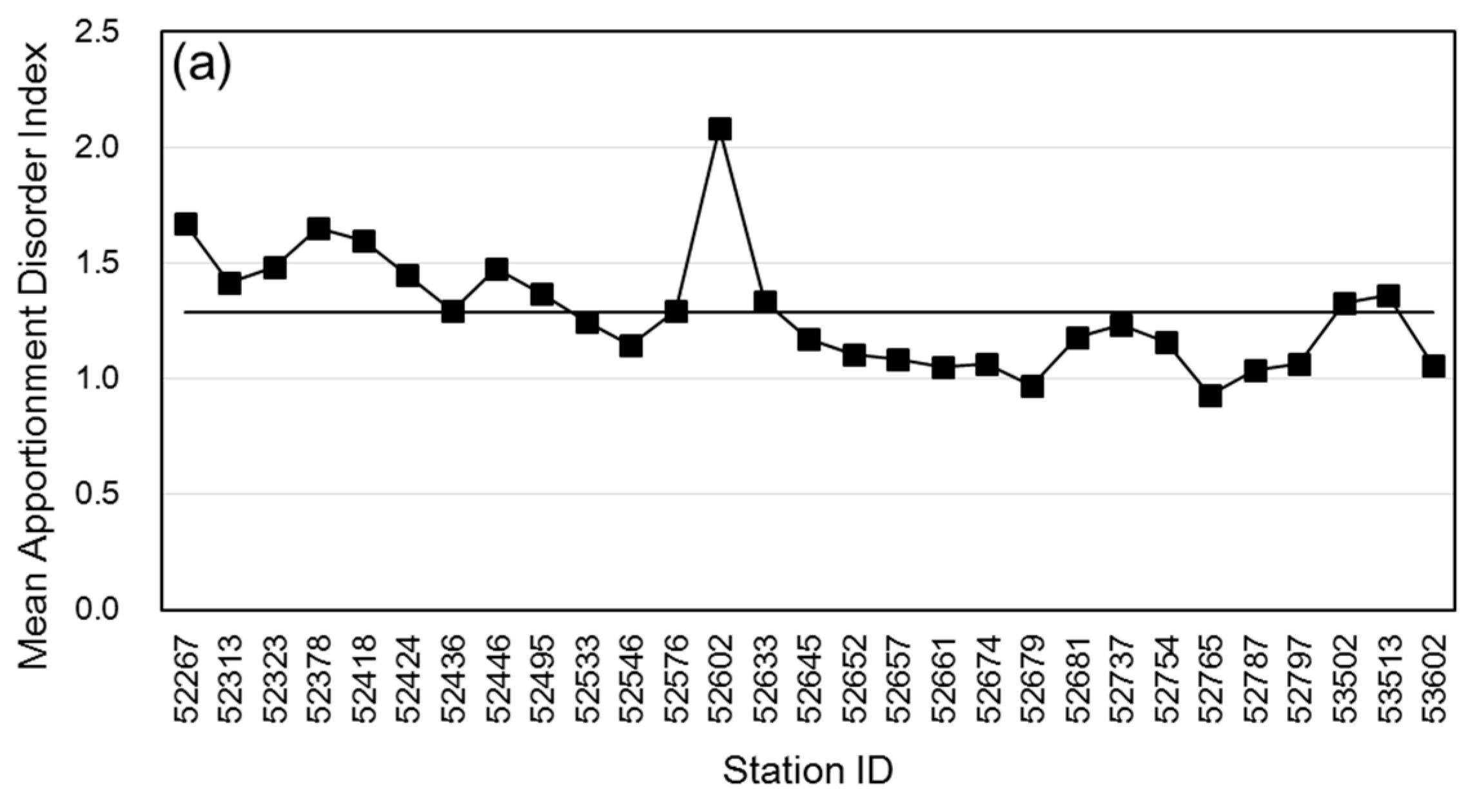
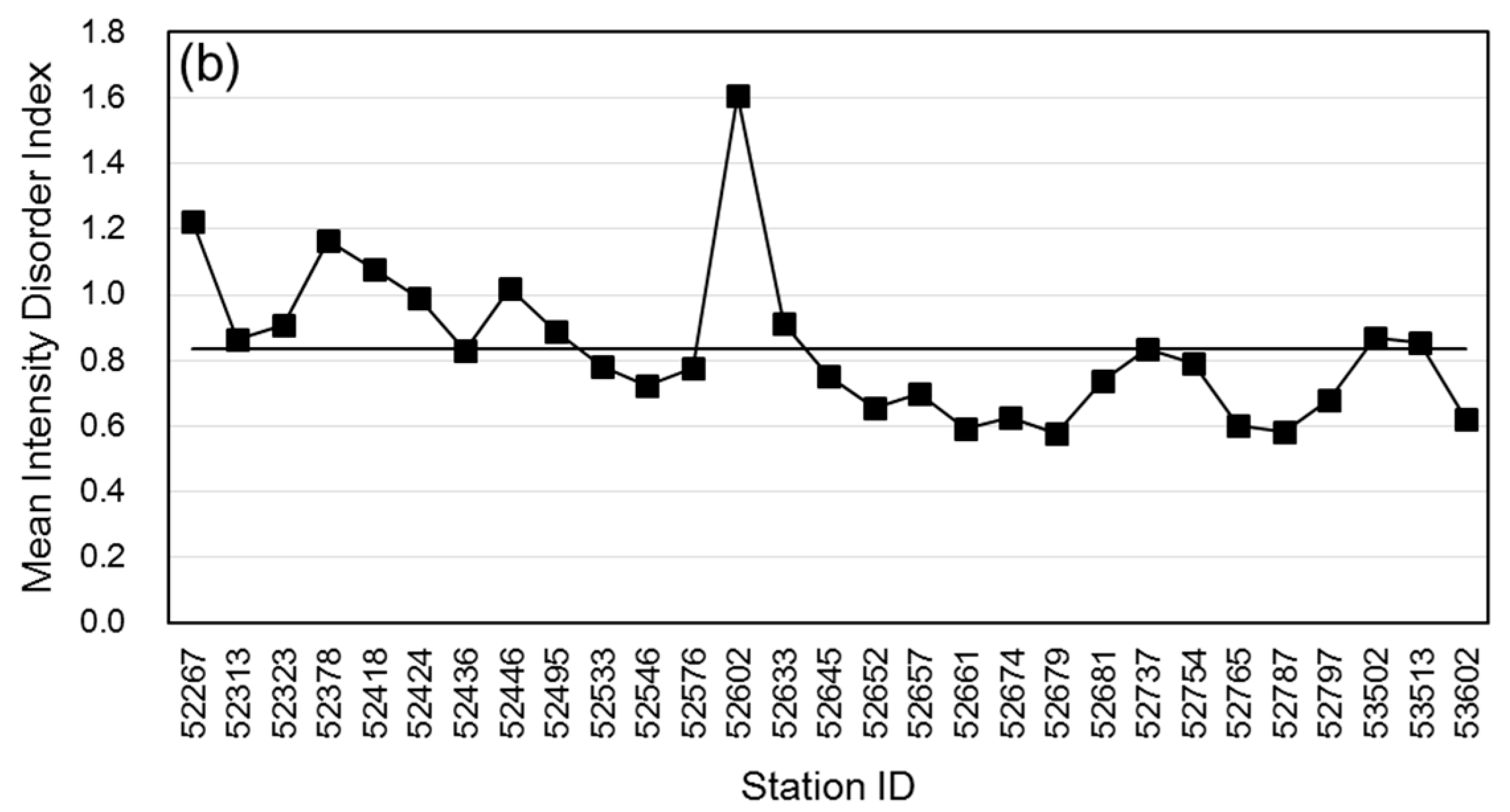
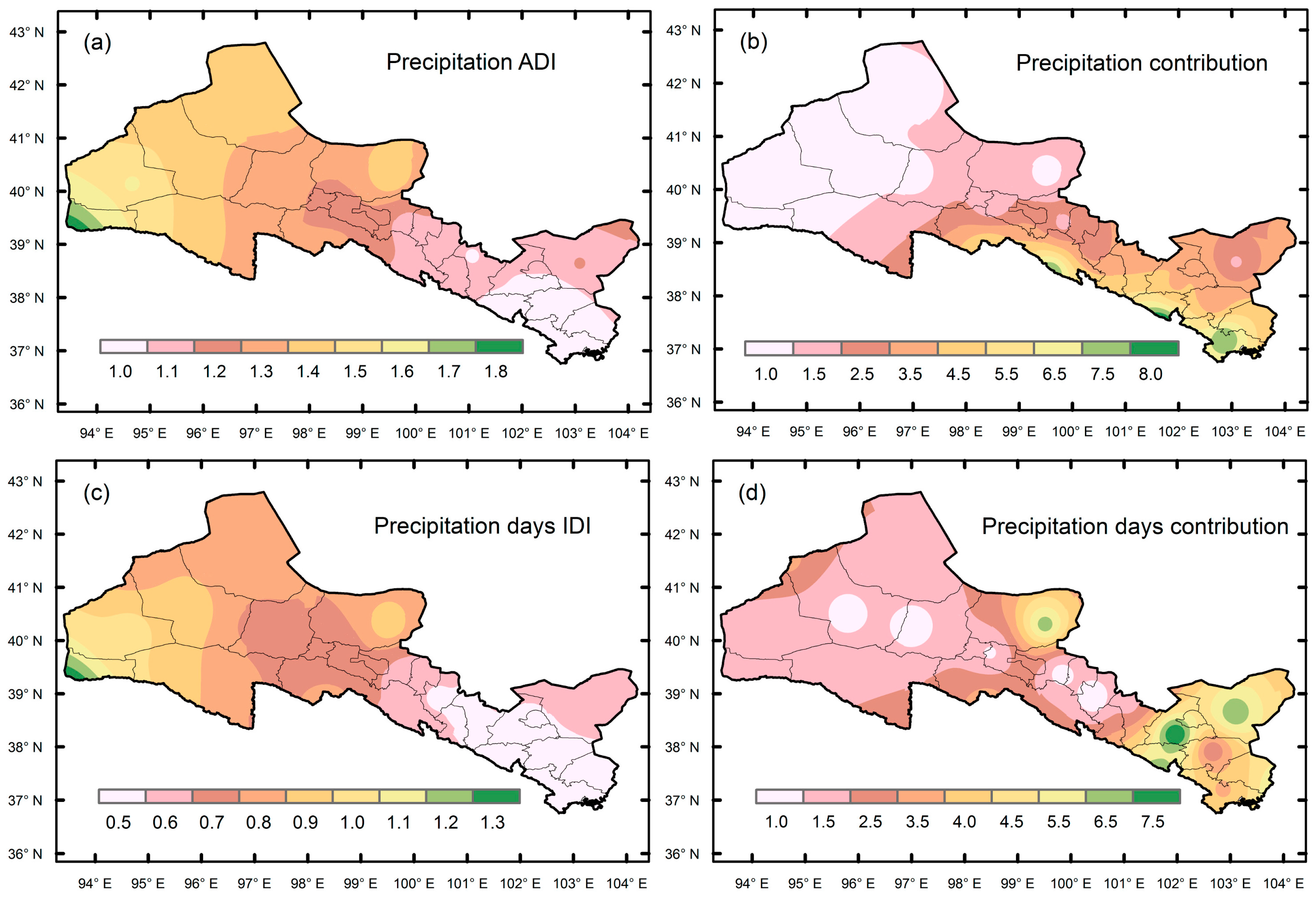
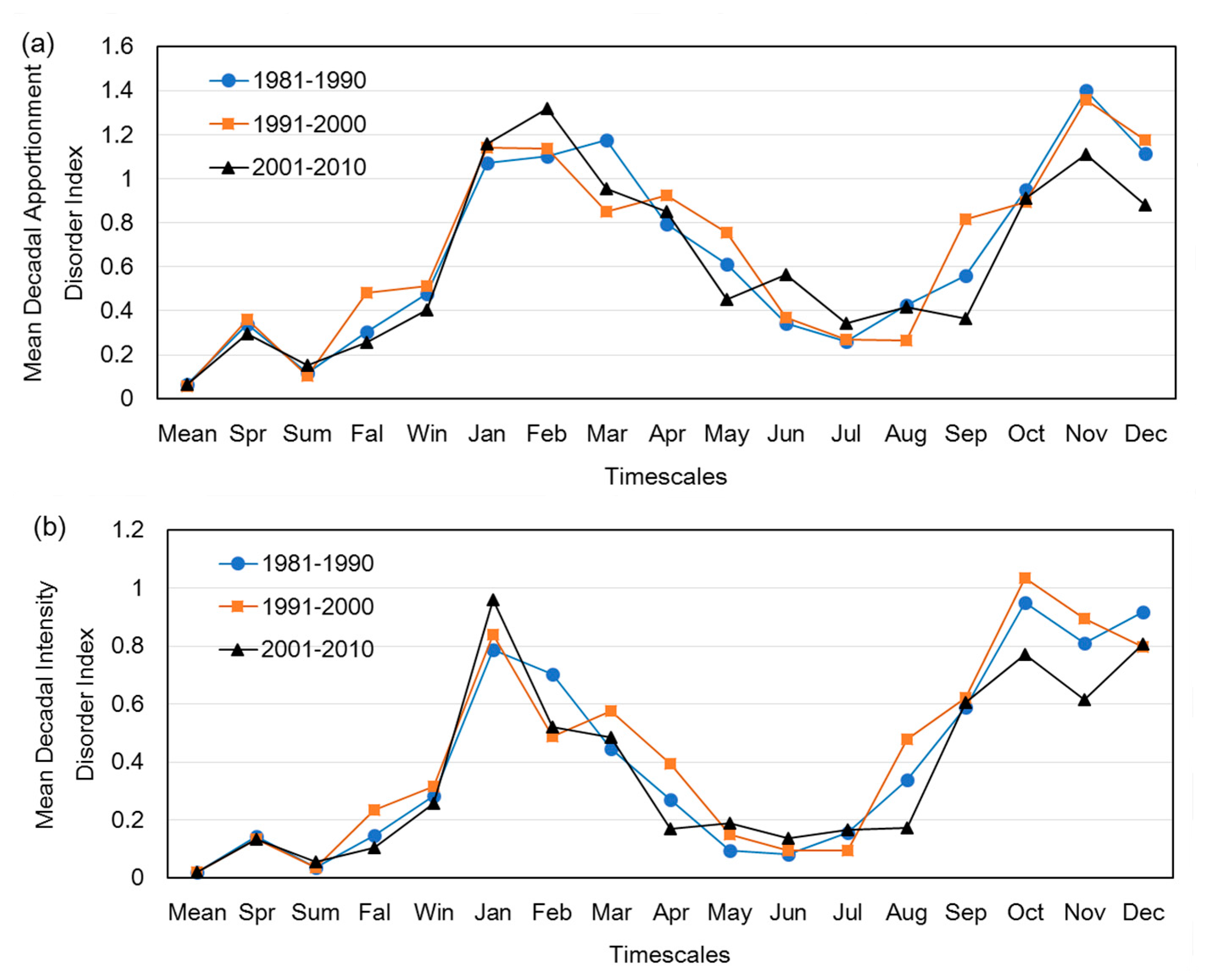
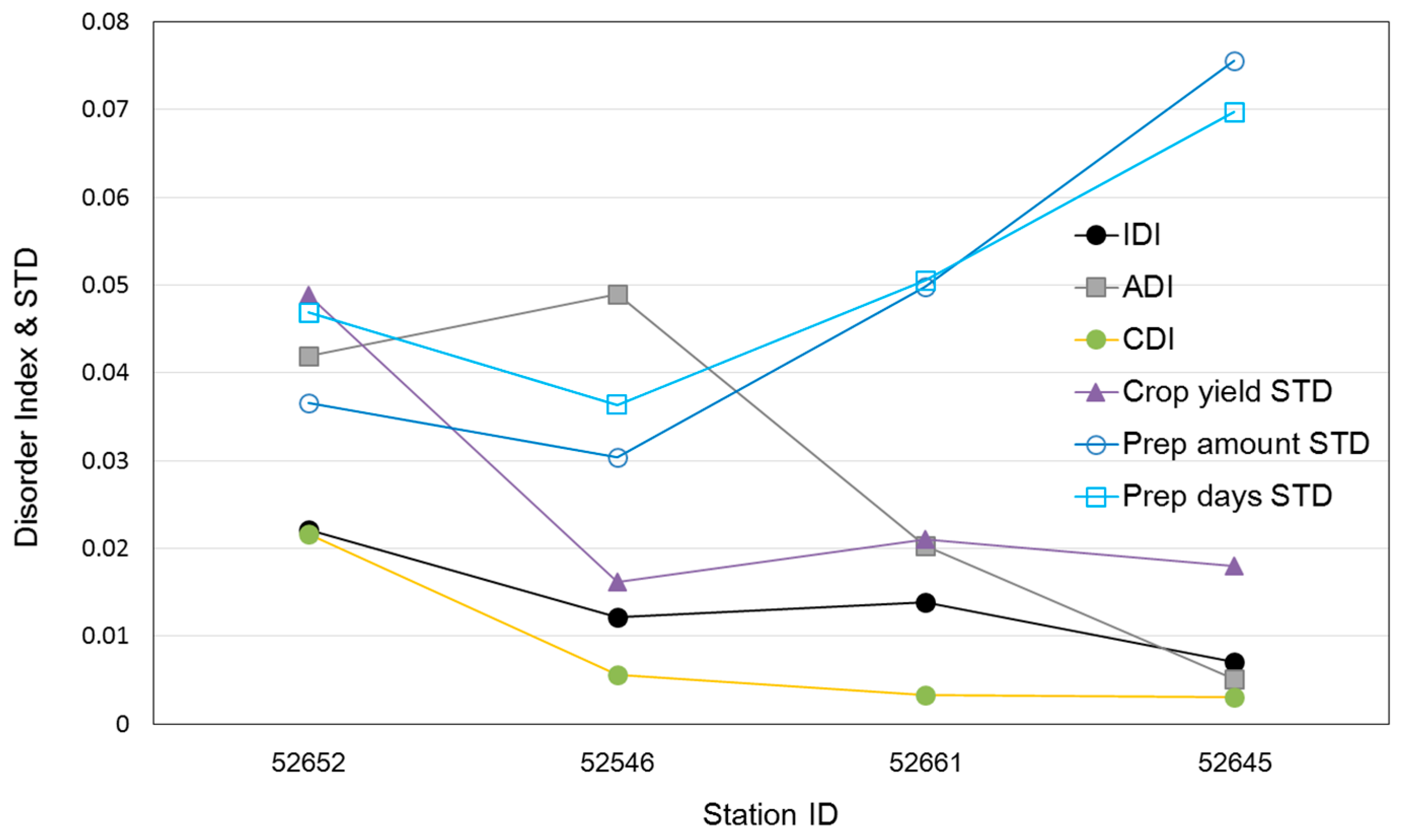

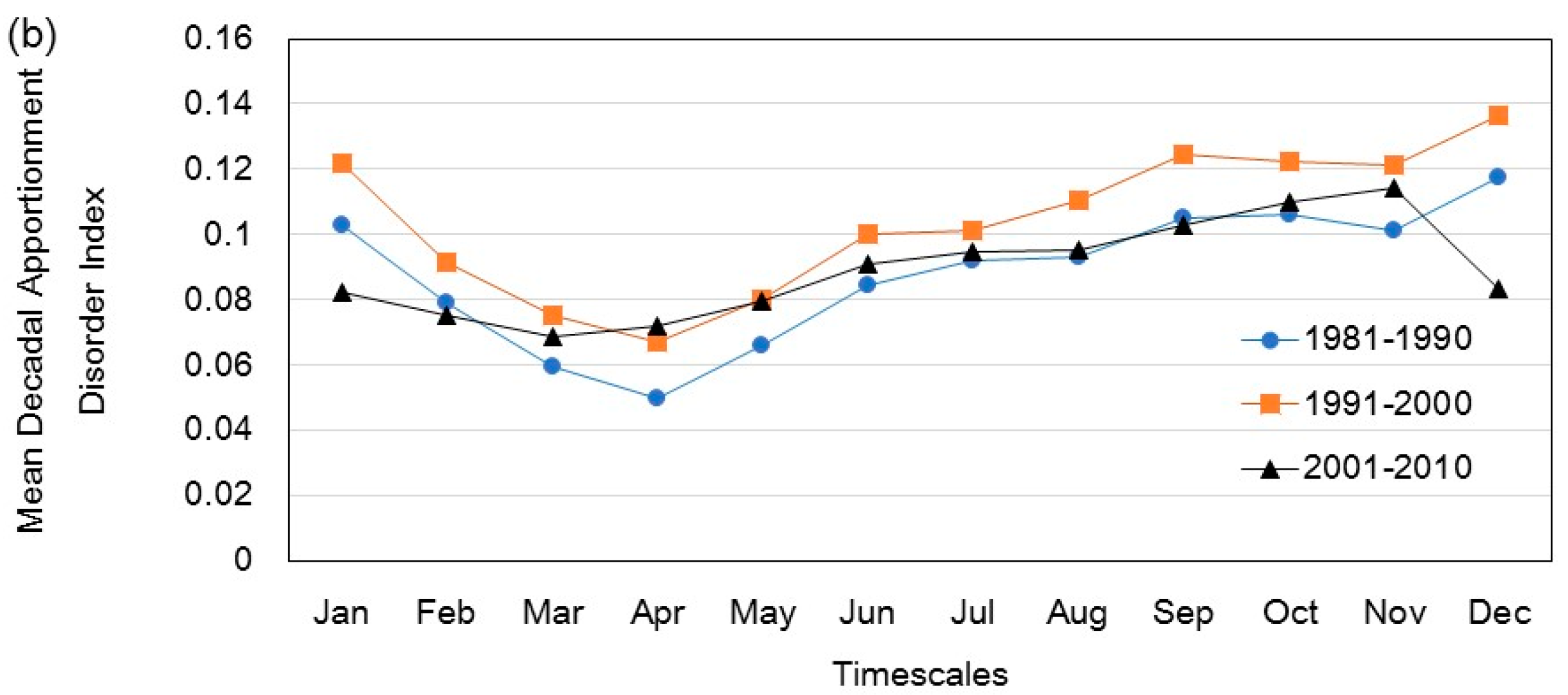
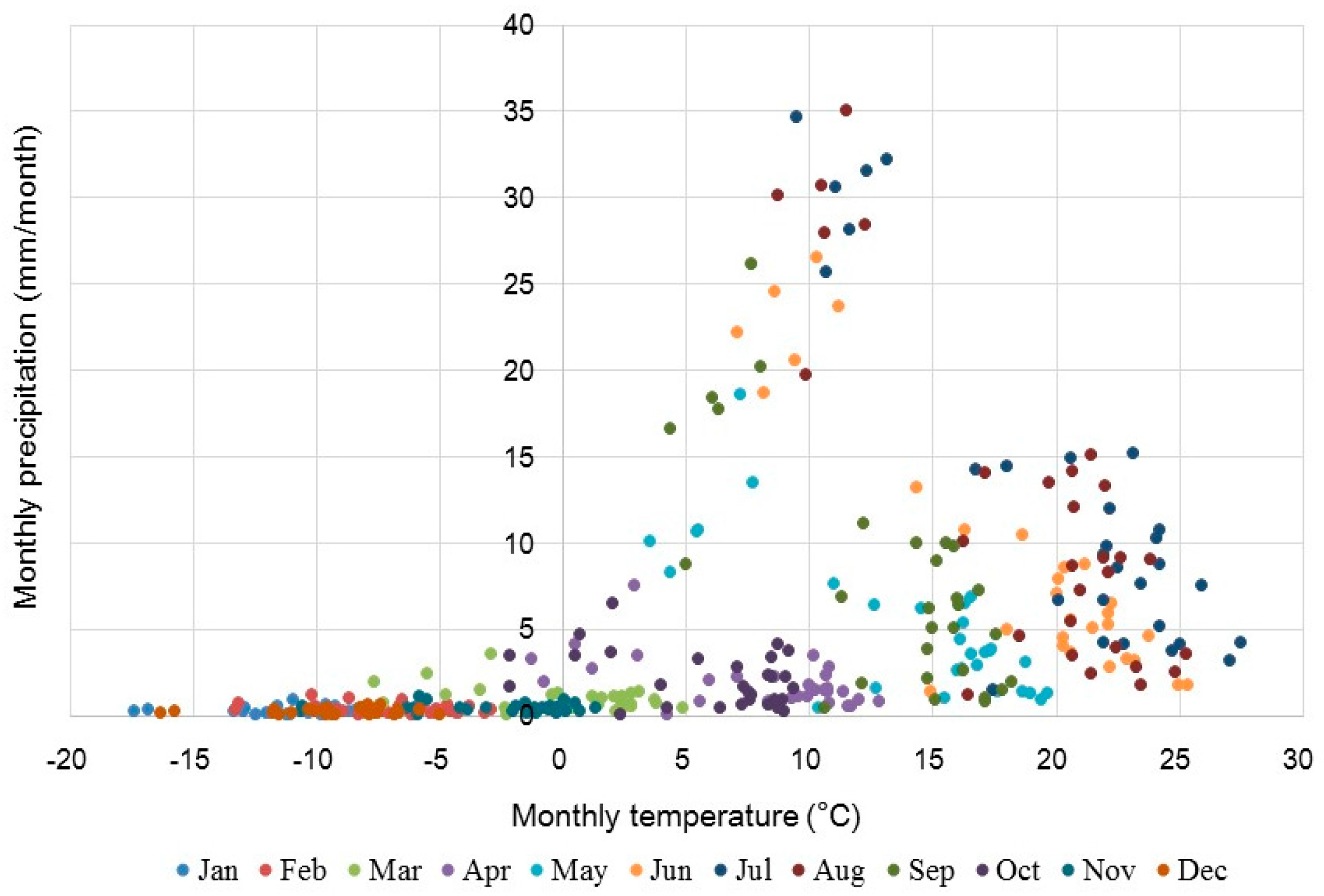
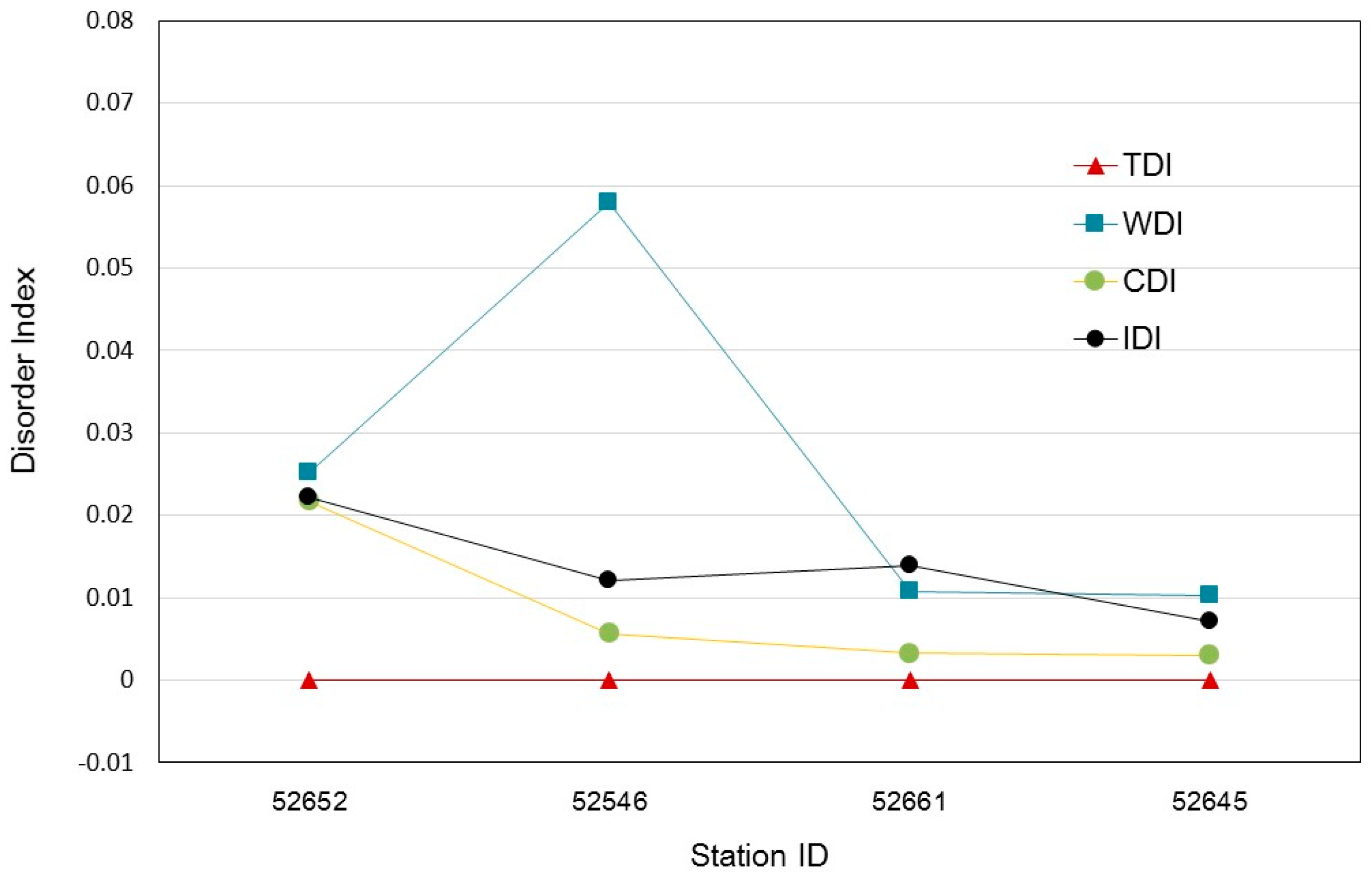
| Station No. | Station ID | Latitude (Decimal Degrees) | Longitude (Decimal Degrees) |
|---|---|---|---|
| 1 | 52267 | 41.95 | 101.07 |
| 2 | 52313 | 41.53 | 94.67 |
| 3 | 52323 | 41.80 | 97.03 |
| 4 | 52378 | 41.37 | 102.37 |
| 5 | 52418 | 40.15 | 94.68 |
| 6 | 52424 | 40.53 | 95.77 |
| 7 | 52436 | 40.27 | 97.03 |
| 8 | 52446 | 40.30 | 99.52 |
| 9 | 52495 | 40.17 | 104.80 |
| 10 | 52533 | 39.77 | 98.48 |
| 11 | 52546 | 39.37 | 99.83 |
| 12 | 52576 | 39.13 | 101.41 |
| 13 | 52602 | 38.75 | 93.33 |
| 14 | 52633 | 38.80 | 98.42 |
| 15 | 52645 | 38.42 | 99.58 |
| 16 | 52652 | 38.93 | 100.43 |
| 17 | 52657 | 38.18 | 105.25 |
| 18 | 52661 | 38.80 | 101.08 |
| 19 | 52674 | 38.23 | 101.97 |
| 20 | 52679 | 37.92 | 102.67 |
| 21 | 52681 | 38.63 | 103.08 |
| 22 | 52737 | 37.37 | 97.37 |
| 23 | 52754 | 37.33 | 100.13 |
| 24 | 52765 | 37.38 | 101.62 |
| 25 | 52787 | 37.20 | 102.87 |
| 26 | 52797 | 37.18 | 104.05 |
| 27 | 53502 | 39.47 | 105.45 |
| 28 | 53513 | 40.45 | 107.25 |
| 29 | 53602 | 38.50 | 105.40 |
| Station No. | Station ID | ATP/MTP (mm) | ATD/MTD (Day) | ||||||
|---|---|---|---|---|---|---|---|---|---|
| Max. | Min. | Mean | STD | Max. | Min. | Mean | STD | ||
| 1 | 52267 | 77.3/45.5 | 7.0/0 | 34.2/2.8 | 18.2/5.7 | 32/15 | 10/0 | 19.9/1.7 | 5.4/2.1 |
| 2 | 52313 | 95.3/40.9 | 16.9/0 | 50.5/4.2 | 19.5/6.9 | 42/10 | 22/0 | 30.0/2.5 | 5.7/2.1 |
| 3 | 52323 | 114.9/56.7 | 30.1/0 | 63.8/5.3 | 26.5/9.2 | 60/13 | 23/0 | 33.8/2.8 | 7.9/2.5 |
| 4 | 52378 | 105.2/54.6 | 13.9/0 | 42.1/3.5 | 23.9/7.2 | 26/10 | 12/0 | 18.4/1.5 | 3.6/1.8 |
| 5 | 52418 | 105.3/81.7 | 11.6/0 | 42.6/3.5 | 21.4/7.2 | 34/10 | 14/0 | 22.4/1.9 | 4.8/2.0 |
| 6 | 52424 | 83.6/53.0 | 19.0/0 | 50.8/4.2 | 15.7/6.8 | 40/10 | 19/0 | 25.6/2.1 | 5.2/2.2 |
| 7 | 52436 | 123.0/53.3 | 33.6/0 | 66.5/5.5 | 19.6/7.8 | 49/11 | 25/0 | 35.2/2.9 | 5.9/2.4 |
| 8 | 52446 | 108.5/58.6 | 28.4/0 | 60.4/5.0 | 21.6/8.6 | 42/14 | 19/0 | 30.8/2.6 | 6.2/2.7 |
| 9 | 52495 | 187.5/76.9 | 42.8/0 | 104.5/8.7 | 38.9/13.9 | 53/13 | 21/0 | 36.6/3.0 | 6.9/3.0 |
| 10 | 52533 | 157.3/67.8 | 41.4/0 | 88.4/7.4 | 30.3/10.9 | 60/13 | 28/0 | 39.4/3.3 | 7.5/2.8 |
| 11 | 52546 | 191.0/69.7 | 54.9/0 | 119.0/9.9 | 30.4/12.6 | 64/16 | 35/0 | 49.1/4.1 | 7.3/3.3 |
| 12 | 52576 | 197.6/98.0 | 76.6/0 | 134.8/11.2 | 30.8/16.7 | 65/16 | 34/0 | 48.8/4.1 | 7.9/3.6 |
| 13 | 52602 | 35.8/19.5 | 5.2/0 | 15.4/1.3 | 7.2/2.6 | 22/8 | 6/0 | 12.9/1.1 | 4.3/1.5 |
| 14 | 52633 | 404.4/152.4 | 180.7/0 | 309.7/25.8 | 57.7/33.5 | 109/23 | 74/0 | 88.3/7.4 | 10.3/6.3 |
| 15 | 52645 | 602.3/151.0 | 274.9/0 | 426.4/35.5 | 75.5/41.5 | 159/28 | 100/0 | 125.5/10.5 | 13.9/7.4 |
| 16 | 52652 | 216.3/90.3 | 71.6/0 | 132.6/11.0 | 36.6/14.4 | 73/15 | 37/0 | 53.9/4.5 | 9.4/3.4 |
| 17 | 52657 | 573.1/162.4 | 331.0/0 | 415.1/34.6 | 61.5/40.1 | 139/26 | 87/0 | 112.0/9.3 | 12.7/7.1 |
| 18 | 52661 | 301.2/107.8 | 97.8/0 | 202.6/16.9 | 49.8/20.8 | 93/17 | 51/0 | 68.4/5.7 | 10.1/3.8 |
| 19 | 52674 | 294.6/128.0 | 110.5/0 | 211.7/17.6 | 40.4/22.3 | 95/20 | 52/0 | 73.4/6.1 | 11.9/4.5 |
| 20 | 52679 | 251.3/111.9 | 101.6/0 | 171.0/14.3 | 40.8/17.8 | 83/14 | 46/0 | 60.9/5.1 | 7.9/3.6 |
| 21 | 52681 | 202.0/73.2 | 52.0/0 | 113.2/9.4 | 29.9/13.1 | 53/14 | 24/0 | 39.7/3.3 | 7.9/3.0 |
| 22 | 52737 | 354.9/145.1 | 128.4/0 | 214.3/17.9 | 58.1/24.2 | 87/20 | 36/0 | 59.8/5.0 | 12.2/4.5 |
| 23 | 52754 | 535.7/162.3 | 263.7/0 | 411.9/34.3 | 61.2/40.6 | 141/26 | 89/0 | 110.7/9.2 | 11.9/7.5 |
| 24 | 52765 | 730.7/201.2 | 404.0/0 | 531.1/44.3 | 72.3/44.2 | 153/26 | 107/0 | 130.8/10.9 | 13.7/6.9 |
| 25 | 52787 | 543.3/172.2 | 274.0/0 | 407.0/33.9 | 58.6/36.4 | 183/27 | 112/0 | 140.5/11.7 | 13.7/5.8 |
| 26 | 52797 | 298.4/95.4 | 94.8/0 | 179.8/15.0 | 54.3/19.1 | 77/16 | 42/0 | 56.1/4.7 | 9.7/3.9 |
| 27 | 53502 | 189.1/94.5 | 56.8/0 | 101.8/8.5 | 34.1/13.7 | 46/13 | 22/0 | 33.0/2.8 | 6.2/2.8 |
| 28 | 53513 | 267.9/193.6 | 55.9/0 | 148.9/12.4 | 48.7/21.5 | 52/15 | 22/0 | 36.6/3.0 | 7.4/3.0 |
| 29 | 53602 | 347.3/103.8 | 126.2/0 | 213.7/17.8 | 55.3/22.3 | 65/15 | 37/0 | 53.2/4.4 | 7.1/3.3 |
© 2017 by the authors. Licensee MDPI, Basel, Switzerland. This article is an open access article distributed under the terms and conditions of the Creative Commons Attribution (CC BY) license (http://creativecommons.org/licenses/by/4.0/).
Share and Cite
Cheng, L.; Niu, J.; Liao, D. Entropy-Based Investigation on the Precipitation Variability over the Hexi Corridor in China. Entropy 2017, 19, 660. https://doi.org/10.3390/e19120660
Cheng L, Niu J, Liao D. Entropy-Based Investigation on the Precipitation Variability over the Hexi Corridor in China. Entropy. 2017; 19(12):660. https://doi.org/10.3390/e19120660
Chicago/Turabian StyleCheng, Liang, Jun Niu, and Dehai Liao. 2017. "Entropy-Based Investigation on the Precipitation Variability over the Hexi Corridor in China" Entropy 19, no. 12: 660. https://doi.org/10.3390/e19120660





